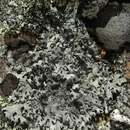Comprehensive Description
provided by Smithsonian Contributions to Botany
Hypotrachyna rockii
Parmelia rockii Zahlbruckner, 1912:379. [Type collection: Kauai, Hawaii, Rock 7 (W, lectotype; US, isotype).]
Thallus adnate to loosely attached, 5–12 cm in diameter, whitish mineral gray; lobes sublinear, 1–6 mm wide; upper surface plane, shiny, often distinctly white-maculate, pustulate initially near the lobe tips, usually becoming coarsely sorediate; medulla white except for pale orange spots under the soralia; lower surface black, densely rhizinate. Apothecia rarely developed, adnate, 2–8 mm in diameter; spores 5μ–7μ × 11μ–14μ.
CHEMISTRY.—Cortex K+ yellow, medulla K−, C+ rose, P− (atranorin, evernic acid, and lecanoric acid).
DISTRIBUTION.—Southeastern United States to southern Chile, South Africa, Southeast Asia, and Hawaii.
HABITAT.—On tree bark (oaks, pine, Ficus, Drimys) and rocks in open forests at 1000–3300 m elevation.
- bibliographic citation
- Hale, Mason E., Jr. 1975. "A Revision of the Lichen Genus Hypotrachyna (Parmeliaceae) in Tropical America." Smithsonian Contributions to Botany. 1-73. https://doi.org/10.5479/si.0081024X.25
Comprehensive Description
provided by Smithsonian Contributions to Botany
Parmelia rockii
Parmelia rockii Zahlbruckner, 1912, p. 379.
P. subbahiana Zahlbruckner in Magnusson, 1942, p. 8. [Type collection: Kilauea, Kauai, Hawaii, Faurie 65 (W, lectotype; P, isotype).]
P. majuscula Zahlbruckner in Magnusson and Zahlbruckner, 1944, p. 92. [Type collection: Kahaluamano, Kauai, Hawaii, Rock 174 (W, lectotype).]
TYPE COLLECTION.—Kauai, Hawaii, Rock 7 (W, holotype; US, isotype).
DESCRIPTION.—Thallus adnate to loosely adnate, 5–12 cm in diameter, whitish mineral gray; lobes sublinear-elongate, 1–6 mm wide; upper surface plane, shiny, maculate, pustulate, the pustules mostly subterminal, usually becoming coarsely sorediate; medulla white except for pale yellow-orange spots under the soralia; lower surface black, densely rhizinate, the rhizines dichotomously branched. Apothecia rare (not seen in Dominica), adnate, 2–8 mm in diameter; spores 5–7×11–14μ.
CHEMISTRY.—Cortex K+ yellow (atranorin); medulla K–, C+, KC+ rose, P– (evernic acid and traces of lecanoric acid).
WORLD DISTRIBUTION AND HABITATS.—Southeastern United States (Virginia and North Carolina), West Indies, Mexico and Central America, northern South America, South Africa, southeast Asia, Hawaii; on rocks and trees at higher elevations (650 to 2,500 m).
Parmelia rockii is very common in the mountains of the tropics, especially in Hawaii and Central America, but has usually been misidentified. It is the pustulate-sorediate member of a chemically identical group that includes isidiate P. bogotensis Vainio and non-sorediate, nonisidiate P. pulvinata Fée. It is morphologically parallel to the P. laevigata group, which differs in containing the barbatic acid complex (see discussion under P. imbricatula). In Dominica, P. rockii behaves as a rain forest species but appears to be quite rare, although common elsewhere in the West Indies.
SPECIMEN EXAMINED.—Hale collection: 15 (35586).
- bibliographic citation
- Hale, Mason E., Jr. 1971. "Morden-Smithsonian Expedition to Dominica: The Lichens (Parmeliaceae)." Smithsonian Contributions to Botany. 1-25. https://doi.org/10.5479/si.0081024X.4

